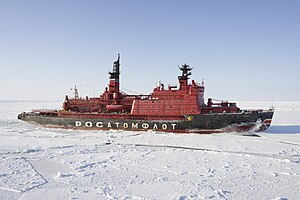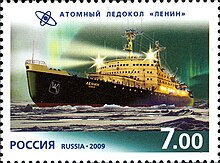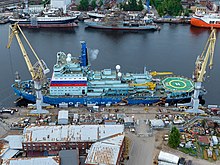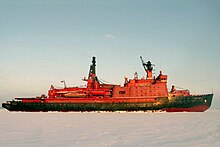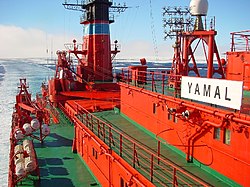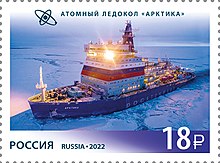
The Northeast Passage is the shipping route between the Atlantic and Pacific Oceans, along the Arctic coasts of Norway and Russia. The western route through the islands of Canada is accordingly called the Northwest Passage (NWP).

Sevmorput is a Russian nuclear-powered cargo ship. The 1988-built vessel is one of only four nuclear-powered merchant ships ever built and, after returning to service in 2016 following an extensive refit, the only such vessel to remain in service as of 2023.

An icebreaker is a special-purpose ship or boat designed to move and navigate through ice-covered waters, and provide safe waterways for other boats and ships. Although the term usually refers to ice-breaking ships, it may also refer to smaller vessels, such as the icebreaking boats that were once used on the canals of the United Kingdom.

The Northern Sea Route (NSR) is a shipping route about 5,600 kilometres (3,500 mi) long, defined by Russian legislation as running from the entrances to the Novaya Zemlya straits in the west, along the Russian Arctic coast above Siberia through the Kara Sea, Laptev Sea, East Siberian Sea, and Chukchi Sea, to Cape Dezhnyov on the Bering Strait, at parallel 66 ° N and meridian of 168 ° 58′37 ″ W.

Nuclear marine propulsion is propulsion of a ship or submarine with heat provided by a nuclear reactor. The power plant heats water to produce steam for a turbine used to turn the ship's propeller through a gearbox or through an electric generator and motor. Nuclear propulsion is used primarily within naval warships such as nuclear submarines and supercarriers. A small number of experimental civil nuclear ships have been built.

Yamal is a Russian Arktika-class nuclear-powered icebreaker operated by Atomflot. She is named after the Yamal Peninsula in Northwest Siberia; the name means End of the Land in Nenets.

The Arktika class is a Russian class of nuclear-powered icebreakers. Formerly known as Project 10520 nuclear-powered icebreaker, they were the world's largest and most powerful icebreakers until the 2016 launch of the first Project 22220 icebreaker, also named Arktika.

Arktika is a retired nuclear-powered icebreaker of the Soviet Arktika class. In service from 1975 to 2008, she was the first surface ship to reach the North Pole, a feat achieved on August 17, 1977, during an expedition dedicated to the 60th anniversary of the October Revolution.

50 Let Pobedy is a Russian Arktika-class nuclear-powered icebreaker.
Soviet naval reactors have been used to power both military and civilian vessels, including:

Taymyr is a shallow-draft nuclear-powered icebreaker, and the first of two similar vessels. She was built in 1989 for the Soviet Union in Finland, at the Helsinki Shipyard by Wärtsilä Marine, by order of the Murmansk Shipping Company. Her sister ship is Vaygach.
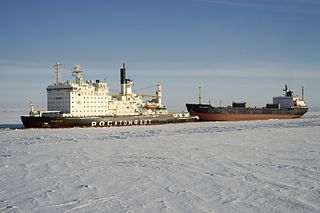
Vaygach is a shallow-draught nuclear-powered icebreaker. She was built in 1989 for the Soviet Union by Wärtsilä Marine Helsinki Shipyard in Finland by order of the Murmansk Shipping Company and its KL-40 reactor was installed at the Baltic Shipyard in St. Petersburg. Her sister ship is Taymyr.

Project 22220, also known through the Russian type size series designation LK-60Ya, is a series of Russian nuclear-powered icebreakers. The lead ship of the class, Arktika, was delivered in 2020 and surpassed the preceding Soviet-built series of nuclear-powered icebreakers as the largest and most powerful icebreaker in the world.

Arktika is a Russian nuclear-powered icebreaker built by Baltic Shipyard in Saint Petersburg. It is the lead ship of Project 22220 icebreakers and superseded the preceding class of nuclear-powered icebreakers as the largest and most powerful icebreaker ever constructed.
Sibir is a Russian Project 22220 nuclear-powered icebreaker. Built by Baltic Shipyard in Saint Petersburg, the vessel was laid down in 2015, launched in 2017, and delivered in December 2021.

Ural is a Russian Project 22220 nuclear-powered icebreaker. Built by Baltic Shipyard in Saint Petersburg, the vessel was laid down in 2016, launched in 2019 and delivered in 2022.
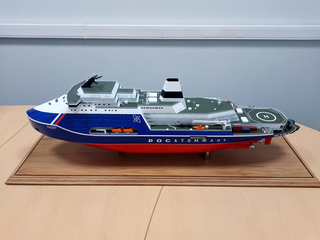
Project 10510, also known through the Russian type size series designations LK-110Ya and LK-120Ya or the project name Leader, is a planned series of Russian nuclear-powered icebreakers. Designed in the 2010s, when built in the 2020s, it would supersede Project 22220 icebreakers as the largest and most powerful icebreakers in the world.

Dikson is a Russian icebreaker and the final vessel in a series of three subarctic icebreakers built at Wärtsilä Helsinki shipyard in Finland in 1982–1983. The vessel's sister ships are Mudyug and Magadan.
Yakutiya is a Russian Project 22220 nuclear-powered icebreaker currently under construction at Baltic Shipyard in Saint Petersburg.
Chukotka is a Russian Project 22220 nuclear-powered icebreaker currently under construction at Baltic Shipyard in Saint Petersburg.
